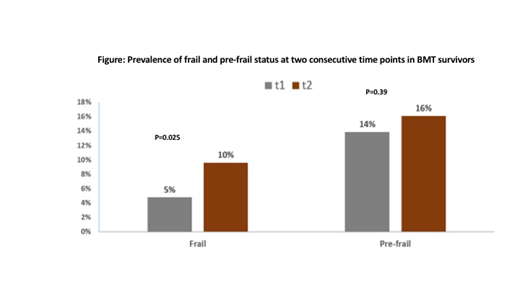Introduction: Frailty is a state of increased vulnerability resulting in a decline in reserve and function across multiple physiologic systems such that the ability to cope with every day or acute stressors is compromised. We previously reported that BMT recipients with frailty were at a 2.8-fold higher risk of subsequent mortality (JAMA Oncol. 2016;2:1277-86) when compared with non-frail survivors. However, longitudinal trends in frailty several years after BMT are not known, and could possibly help in identifying the vulnerable sub-populations at highest risk of subsequent adverse events. We used BMTSS to report transitions in the frailty state over time.
Methods: We included 484 patients who were i) transplanted for a hematologic malignancy between 1974 and 1998 at 2 sites and had survived ≥2y post-BMT; ii) were ≥18y of age at study participation; and iii) were alive both at completion of the baseline survey (t1: median of 7.3 y after BMT) and at follow-up survey (t2: median of 20.6y after BMT); median interval between t1 and t2 was 13.2y. Frailty phenotype used the previous definition (JAMA Oncol. 2016;2:1277-86), and included the presence of ≥3 of the following indices: 1) clinically underweight (body mass index [BMI] <18.5); (2) exhaustion; (3) low energy expenditure; (4) slowness; and (5) weakness. Patients reporting the presence of 1-2 of the 5 indices were classified as pre-frail. We created the following categories of change in frailty status over time; A) Worsening of frailty status/ stable frail status : pre-frailty [t1] → frailty [t2]; no-frailty [t1] → pre-frailty/frailty [t2]; and frailty [t1] → frailty [t2]; B) Improvement of frailty status: frailty [t1] → pre-frailty [t2]; pre-frailty [t1] → no frailty [t2]; C) Stable non-frail/pre-frail status: non-frail [t1]→ non-frail [t2]; pre-frail [t1] → pre-frail [t2]. We used logistic regression to evaluate predictors of A) worsening of frailty status/stable frail status, and B) frailty at t2, controlling for age at questionnaire, sex, diagnosis, smoking status, socio-economic, and BMT related variables (conditioning, donor type, presence of cGvHD), grade 3-4 chronic health conditions, and pre-BMT treatments therapeutic exposures.
Results: Median age (range) at t1 was 42.9y (18.5-67.4) and at t2 was 56.5y (31.0-80.0); 49.4% were females; 85.4% non-Hispanic whites; 15% had <high school education, and 50% had annual household income of <$60,000. Primary diagnoses included acute leukemia (31%), lymphoma (31%), and chronic myelogenous leukemia (25%); 57% had received an allogeneic BMT; 77% received TBI; 40.3% had cGvHD. Prevalence of frailty was 4.8% at t1 and 9.6% at t2, and that of pre-frailty was 13.9% at t1 and 16.1% at t2 (Figure). Worsening of frailty status was seen in 18.8% of the patients, improvement in 9.7%; 68.7% of the patients remained non-frail or pre-frail. Predictors of worsening of frailty status: Pre-BMT exposure to vincristine (OR=5.1, 95%CI: 2.3-11.4) and female sex (OR=1.5, 95%CI, 0.9-2.6, p=0.08) were associated with worsening. Predictors of frailty at t2: Pre-BMT exposure to vincristine (OR=4.6, 95%CI, 1.7-12.5, p=0.003), history of cGvHD at t1 (OR=2.3, 95%CI, 1.0-5.2, p=0.04) and grades 3-4 chronic health conditions at t1 (OR=2.1, 95%CI, 1.0-4.5, p=0.04) were associated with frailty at t2. Age was not a significant predictor in either analysis.
Conclusions: In a cohort of patients followed longitudinally for a median of 20.6y from BMT, with measurement of frailty status 13.2y apart, we observed that the frailty status worsened for ~20% of the patients. Pre-transplant exposure to vincristine was associated with worsening of frailty status. Patients with cGvHD or morbidity at t1, as well as pre-BMT vincristine exposure placed BMT survivors at high risk for subsequent frailty, identifying sub-populations that could benefit from targeted interventions.
Weisdorf:Incyte: Research Funding; Fate Therapeutics: Consultancy; Pharmacyclics: Consultancy.
Author notes
Asterisk with author names denotes non-ASH members.


This feature is available to Subscribers Only
Sign In or Create an Account Close Modal